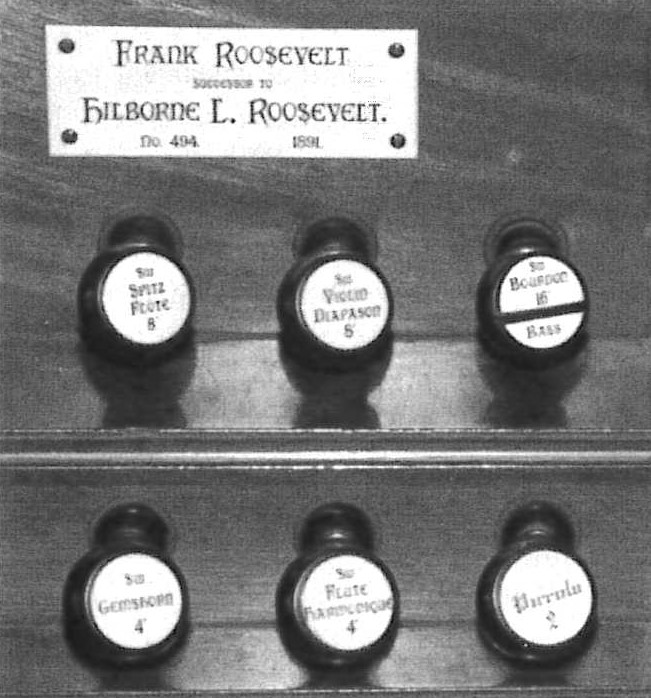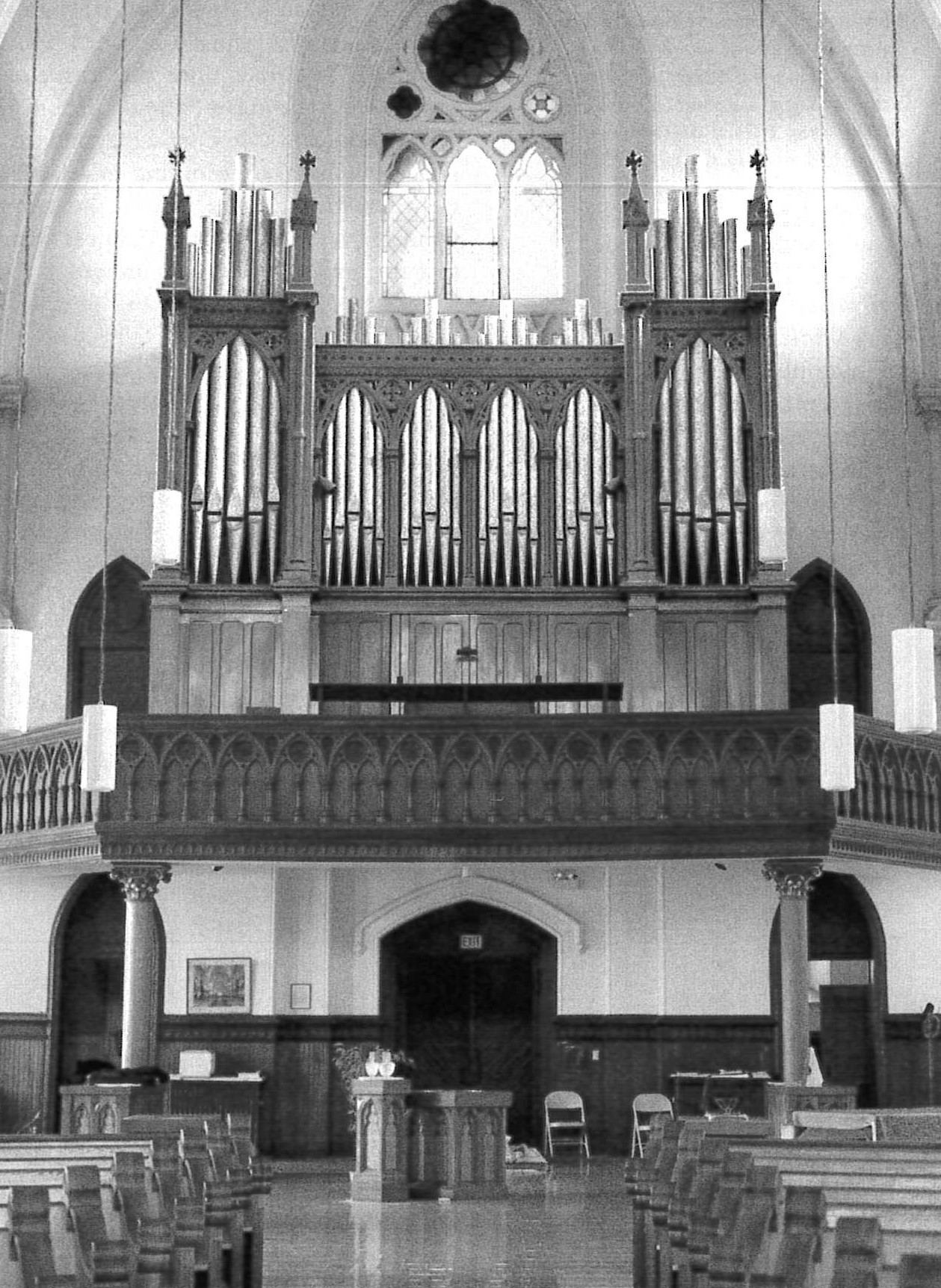St. James Catholic Church
2942 South Wabash Ave
Chicago, IL
OHS convention: 2002
Note: Not extant. Not playable. (in this location)
Images
 2001 - Builder nameplate and six knobs, including the Bourdon split knob (Photograph from an archival source: 2002 OHS Handbook, William T. Van Pelt, submitted by Paul R. Marchesano/Paul R. Marchesano)
2001 - Builder nameplate and six knobs, including the Bourdon split knob (Photograph from an archival source: 2002 OHS Handbook, William T. Van Pelt, submitted by Paul R. Marchesano/Paul R. Marchesano) 2001 - Organ in rear gallery (Photograph from an archival source: 2002 OHS Handbook, William T. Van Pelt, submitted by Paul R. Marchesano/Paul R. Marchesano)
2001 - Organ in rear gallery (Photograph from an archival source: 2002 OHS Handbook, William T. Van Pelt, submitted by Paul R. Marchesano/Paul R. Marchesano) 2013-01-17 - Organ under protective cover during church demolition (Photograph by Alex Fries/Database Manager)
2013-01-17 - Organ under protective cover during church demolition (Photograph by Alex Fries/Database Manager) 2013-01-17 - Tower chime keyboard (Photograph by Alex Fries/Database Manager)
2013-01-17 - Tower chime keyboard (Photograph by Alex Fries/Database Manager) 2013-01-17 - Console detail: manuals (Photograph by Alex Fries/Database Manager)
2013-01-17 - Console detail: manuals (Photograph by Alex Fries/Database Manager)
Consoles
Main
- Organ type: Traditional Without Cover
- Console position: Keydesk Attached
- 2 manuals
- 25 stops
- 3 divisions
- Key action Type: Tubular Pneumatic (Pressure)
- Stop action Type: Tubular Pneumatic (Details Unknown)
- Stop layout Type: Drawknobs in Horizontal Rows on Terraced/Stepped Jambs
- Manual compass: 58 notes
- Pedal compass: 30 notes
- Pedal Type: Flat Straight
- Expression Type: Balanced Expression Shoes/Pedals (Not Meeting AGO Standards)
- Combination action: Adjustable Mechanical
- Has coupler toe pistons
- Has tutti toe pistons
Notes
2004-10-30 - Status Note: There 1984 -Database Manager
2004-10-30 - Tracker-pneumatic. -Database Manager
2007-08-04 - Updated through online information from Stephan Drexler. -- this organ is in need of repair and restoration by someone familiar with Roosevelt action as many repairs were done in the past and poorly causing the organ to cipher whenever the air is dry. None of the key or stop valves have ever been replaced and are well over 100 years old and don't seal well. The return springs on the pipe pneumatics are too weak and don't close all the time, and the gaskets are mostly 1891 vintage as well. When it plays it is one of the most glorious small organs you will ever hear but that is becoming more rare as time goes on. -Database Manager
2012-07-16 - Updated through online information from Carl Scott Zimmerman. -- Under the right end of the keydesk is a swing-out auxiliary keyboard for playing the 20-bell tower chime, which was cast by McShane of Baltimore in 1895. The mechanism is electro-pneumatic, with a rack of individual bellows (one per bell) in the tower room behind the organ, directly below the chimestand, which is on the next higher level within the tower. This mechanism must have been constructed by an organbuilder, and is possibly unique among North American chimes. Depressing a key on the auxiliary keyboard causes a valve to open, exactly as in operating an organ pipe except that it allows air into a normally-closed bellows. The resulting expansion of the bellows pulls down a wire which passes through the ceiling of the room and through a hole drilled in the appropriate handle (key, lever) of the chimestand, thus pulling down that handle and causing the bell to ring. Since the chime was installed a few years after the organ, and since the chimestand was modified when this additional mechanism was installed, it seems likely that this additional mechanism was installed at an even later date. I cannot hazard even a guess at who did it or when, except that it is quite old. -Database Manager
2014-02-08 - Updated through online information from Alex Fries. -- The church has been demolished. The organ was dismantled and put into storage by the Organ Clearinghouse company. -Database Manager
Stoplist
Typed stoplist from the OHS PC Database. Source: Source not recorded Date not recorded
St. James RC Church, Chicago, IL
1891 Frank Roosevelt, Op 494
(Stoplist: David Schnute from T 10:4:4)
GREAT
16' Double open diapason
8' Open diapason
8' Doppelflöte
8' Gamba
8' Dulciana
4' Octave
4' Holflöte
2-2/3' Octave quint
2' Super octave
8' Trumpet
SWELL
16' Bourdon Bass
16' Bourdon
8' Violin diapason
8' Stopped diapason
8' Spitzflöte
4' Flute harmonique
4' Gemshorn
2' Flageolet
III Cornet
8' Cornopean
8' Oboe
8' Vox humana
tremolo
PEDAL
16' Open diapason
16' Bourdon
8' Cello
/ds/
___________________________________________________________________________________________________
Notes from "The Stopt Diapason," February 1983
All ranks complete to CC; none has stopped or common basses. The Great is enclosed with the Swell
except for the 16' and 8' Open Diapasons, the basses of which are in the facade (all speaking).
The pedal is divided at the sides.
Originall the wind was raised by hand. A very large (six by nine feet) double fold bellows was
fed by three feeder bellows connected to a crankshaft which was mannually operated by a belt
drive. With some exceptions, the manual system remains; a few pieces of hardware are missing.
For the past sixty years or so a Spencer Orgoblo blower has supplied wind electrically. For
reasons unknown it is operated faster than its rated speed (1200 rpm vs. 1075 rpm) The resulting
threnody is vibration from excessive speed and the Spencer Orgoblo's characteristic noisiness.
The wooden parts of the bellows are sound; only the original leather has deteriorated. One set
of ribs in the main bellows has been fastened down, probably in an effort to reduce leakage.
According to a label attached to the c' pipe of the Octave 4', wind pressure was originally set at
three and one half inches water column. Actual tests show the present pressure to be 4-1/2".
Examination of the weights revealed four weights to be of different form and material than the
otherwise uniform 15 or 20 weights distributed over the bellows. Removal of the extra weights
yielded a pressure of just over 4".
Because reed stops are difficult to make, they are often installed several months after the organ
is completed and set up. Examination of three such stops (Trumpet, Cornopean, and Oboe) proved
this to be the case as they bore the date "1892", the year after the organ's installation. The
reeds may have sounded better on pressure greater than 3-1/2". Further study may determine the
added weights to be extraneous and the pressure as (eventually) intended by the builder to be
around four inches.
The console (keydesk) is built into the organ case. The two manuals and pedals control primary
boxes trhough a mechanical system must like that of a tracker organ. The similarty to tracker
ends at the primary box, for the key action from there to the chest is tubular pneumatic. Coupling
of the manual is accomplished by purely mechanical means. The stop action, too, is mechanical up
to the pneumatic ventil boxes which divide the main chests. The console's most distinguishing
feature, an adjustable combination action for deploying stops by means of foot levers, is purely
mechanical. (Small setter levers are above the combination levers.)
All of the above mechanism is intact, though leather and felt are completely worn out. The
platings (ivories) on the keys are modern plastic cheaply done. (This is because the manuals
themselves were replaced some 20 years ago.) All of the pedal caps are original and badly worn.
The combination action and the wind gauge are not in working order. The tremulant needs
recovering. The balanced swell mechanism is in mint condition, however.
The chests, upon which the pipes stand, contain the playing mechanism. They consist of a grid of
channels and wedge shaped bellows called pneumatics which operate valves under the toeboards. The
valves admit wind to the pipes standing on the toeboards when the appropriate keys are played and
stops drawn.
When a key is pressed, a valve in the primary box over the key opens, venting a key channel
running from front to back in the chest common to all the pipes of a given note. When a stop is
drawn, a channel running from left to right is filled with wind. Where the coordinates of key
channel and stop channel cross, the wind creates pressure on the cuneiform bellows (pneumatic)
connected to the key channel. The resulting pressure difference on the tiny bellows causes it to
collapse and move a valve connected to an attached arm. The same wind is then free to enter the
pipe, to make it speak.
There are many such leather covered pneumatics in the organ (over 1,300). The leather was replaced
some years ago by persons unknown who did an inadequate job of recovering, and unwittingly caused
the organ's most serious problem, namely the many ciphers (sticking notes). Though this leather is
good and sound, the hinges on about half the pneumatics are not rigid enough to enable the valves
to seat properly every time. In addition, the arms were not carefully centered and adjusted for
proper sealing. Careful adjustment is necessary for the valves lap the holes by no more than
3/32". In spite of this, the action is very light - pipe speech is prompt and the action repeats
rapidly. The stop action has original leather, all of which is worn.
With the exception of the bottom boards the wood of the chests is sound and straight. Three of the
bottom boards, all of which carry the all important key channels, have been planed down to bare
wood for no apparent reason. Deep impressions left by tiny washers under the screws have caused
some damage as has a futile attempt to improve sealing by replacing the washers with blocks of
wood and longer screws. Some locating dowels are missing.
The case of red oak is generally good; the varnish is good quality and shows no signs of cracking
and crazing as with later finishes. Normal wear at the console has rubbed off some of the finish.
The finish on the case pipes is in good condition though dulled with age.
Inside the case, the electrical wiring is unsafe. Broken light sockets hang by their wires, and
several conduits and cables in various stages of disuse wander aimlessly about the interior.
The inspection revealed this organ to be a stunning example of 19th century American organ
building. It was built with great care in design and craftsmanship by a firm which thoroughly
understood the Romantic idiom. The organ speaks from a perfect location into a church of
herioc proportions. The superb acoustics enhance the organ immeasurably by adding to its
grandeur. (Reverberation time is over 5 seconds.)
Not only organ and acoustic create priceless treasure at St. James Parish, but another fact makes
this instrument outstanding in the greater music community. Very few organs of this type remain,
and no more will ever be built again. As there will never be another Romantic period, so there
will never be another Roosevelt, Tiffany, or Middleschulte. The latter is known as the teacher of
Virgil Fox, and was parish organist for several years at St. James at the beginning of the century.
In light of the above, nothing short of a complete and faithful restoration of the organ should be
done when it is financially possible.
___________________________________________________________________________________________________
(Submitted by T. Daniel Hancock, 2012-09-20)
Documents
Other Links
Regrettably, it is not possible to display the information about the sponsor of this pipeorgandatabase entry or if there is a sponsor. Please see About Sponsors on Pipe Organ Database.




